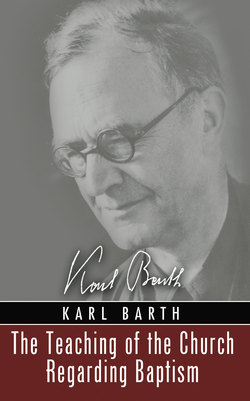Читать книгу The Teaching of the Church Regarding Baptism - Karl Barth - Страница 4
На сайте Литреса книга снята с продажи.
ОглавлениеTRANSLATOR’S PREFACE
BOTH the theology and the practice of the Church in regard to baptism are today the subject of searching thought and discussion in many different Christian traditions. Communions which practise infant-baptism, as well as those which, since the Reformation, have stood for the baptism of believers only, are alike compelled to re-examine their doctrine of the Church and the sacraments. On these matters, as on so many others, the Swiss theologians, and in particular Dr. Barth and Dr. Brunner, have important things to say to the English-speaking world as well as to their own. Professor Emil Brunner discussed baptism in the last chapter of Wahrheit als Begegnung (available for English readers as The Divine-Human Encounter, S.C.M. Press, 1944).
A quarter of a century ago Dr. Barth in his commentary on the Epistle to the Romans wrote as follows:—
“Baptism is a sacrament of truth and holiness; and it is a sacrament, because it is the sign which directs us to God’s revelation of eternal life and declares, not merely the Christian ‘myth,’ but—the Word of God. It does not merely signify eternal reality, but is eternal reality, because it points significantly beyond its own concreteness. Baptism mediates the new creation: it is not itself grace, but from first to last a means of grace. As the question which men put to God is always also His answer to it; as human faith is enclosed invisibly by the faithfulness of God; so also the human act of baptism is enclosed by that action of God on behalf of men which it declares” (E.T., p. 192).
Since then Dr. Barth has developed and systematized the prophetic insights which have made him one of the most stimulating and influential thinkers of our time. He is engaged upon the exposition of a comprehensive Christian dogmatic which will treat in due place of the doctrine of the Church. In the meantime, however, the lecture which follows makes a particular and distinctive contribution to the current discussion of baptism and shows the conclusions to which Dr. Barth has been led by his study of the New Testament. The lecture was delivered to a gathering of Swiss theological students on 7 May, 1943, at Gwatt am Thunersee and was subsequently printed under the title Die Kirchliche Lehre von der Taufe as No. 14 of the series of Theologische Studien, edited by Dr. Barth himself and published by the Evangelischer Verlag A. G. Zollikon—Zürich.
I am grateful to my friends, the Rev. and Mrs. Kurt Emmerich, who first called my attention to the pamphlet and helped to secure Dr. Barth’s permission for this translation. I am very conscious that I have not overcome all the difficulties or avoided all the pitfalls which beset the translator. They are formidable indeed in the case of a theologian of Dr. Barth’s calibre, and with such a subject. How shall Bild, Abbild, Darstellung, Zeichen, etc., be adequately rendered and distinguished in English? My translation, which is from the second edition, would not have reached its present form but for the co-operation of others. Dr. Hugh Martin and the S.C.M. Press Board encouraged me to essay the task when others, more competent than I, drew back. Dr. P. W. Evans gave me encouragement and help on a number of different occasions. Miss Joyce Booth typed my manuscript. Dr. and Mrs. A. B. Crabtree generously and carefully read the typescript and made a number of valuable suggestions. However many the blemishes that remain, I hope it will be clear to every reader that Dr. Barth has things to say to which all those concerned for a true doctrine and practice of baptism should give heed.
ERNEST A. PAYNE
Regent’s Park College,
Oxford.
